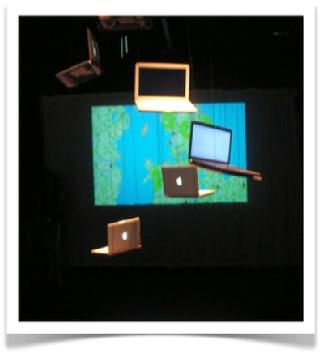Theory Roulette
During the Open-space Learning project Catherine Allen (now Managing Director of Ember Television) was one of our most active and creative student collaborators. Working with Lauren Cameron (another Theatre Studies undergraduate), Catherine created a remarkable Open-space experience as an assessed piece. The original work used an immersive digital environment to get people thinking about identities and digital culture, through the medium of Chat Roulette (a transgressive online sub culture).
Based upon this original idea, we imagined how the same immersive interactive approach could be used for other academic purposes. With the addition of some further more blue-skies technologies, we dreamed-up the idea of Theory Roulette. Here is the story...
---------
Slowly moving from the bright and informal foyer, we pass through two sets of doors, each in turn filtering-out a degree of chattering, confidence and expectation. Into the dark, cavernous and unfamiliar space of the Studio. A little thread of light at the edges guides us into position, strung out along the black-curtained wall.
A few seconds of settled silence, then a crackle of sound coming from somewhere above and near to, we guess, the centre of the room. A second audio source comes to life, just to the side of the first: again just a crackle. Then a screen flickers on, it’s position matching that of the first sound, followed by a second screen with it’s accompanying sound source, followed by a third, a fourth and a fifth, each displaying tuned-out white noise, spiralling around in aerial suspension.
“Hi, I’m Garry from Illinois. Do you wanna chat?”
Garry’s face stares at us from the first screen, fitted-out with a dumbly quizzical expression. A few vacant seconds later, he’s replaced by Monika from Derby. Garry’s performance continues further around the spiral. Monika moves along. Daniel from Frankfurt is next. Ephemeral and disturbing video sequences captured from the strange distributed online world of Chat Roulette, looping around and drawing the line of spectators along and dispersing: examining, making sense of, whispering to each other observations, instant theorisations and refutations, all dimly lit and lo-fi.
|
|
A hanging spiral of laptops. Suspended from the tension grid below the ceiling of the CAPITAL Studio. A backdrop of interactive screens. Lighting set to the minimum safe level. Light reflecting of the curious faces of the invited participants. |
A few minutes into the session, and two wall-sized screens fire up at opposite ends of the space, boxing-in the spiral of suspended screens. Each big screen shows a Google Earth sequence plotting the exact locations of the Chat Roulette participants (to street level), along with the available biographical data. The video sequence zooms in and out to examine each participant and their socio-economic and cultural context. The sequence comes to a halt, replaced by an un-recorded, interactive Google Earth interface pin-pointing each chat participant. The experience is transformed away from passive spectacle to active participation and collaborative exploration, as we use the touch screen to control and explore the information displayed.
By now the audience, or more precisely the explorers, have started taking notes: snapshots and voice memos recorded directly into small portable wifi enabled devices. Each note is tagged to identify it’s context (creator, location, event, time, theme, purpose etc). A third wall-sized touch screen has appeared, displaying an interactive timeline, upon which our notes are plotted, as well as a spatial representation of the room and its contents. We can instantly see each-other’s responses, or return to them later when reflecting upon the experience. We can also add our own materials (images, sounds, texts, videos) collected from other places and times and carried into the space digitally.
After some time exploring and discovering unguided, a fourth interactive wall appears, completing the box. This time it’s a wall of books: key sociological texts on technology and community. We can open each book, spread out selected pages across the screen, annotate and draw around them. Furthermore, we can add to them from the opposite wall, containing our notes and digital recordings. The challenge is obvious: place our own observations and theories in relation to the academic works, build a theory and test it against the empirical evidence that we have explored.
Finally, the session ends with an invitation to summarize and reflect upon our theories and the experience of collaboratively constructing them. We can record these reflections as text, audio or video (or all three), added to our collective timeline or recordings and events (for our later use). But the discussion doesn’t end there, spilling out into blogs, forums and future events, all connected back to the event, and informing future writing and research.
---------
Such a learning experience would be quite extraordinary: active, engaging, haptic, kinaesthetic, reflective, personal, challenging, research-led, social and with a concrete result translating into assessable outputs, and possibly even social change. But would it work? That's a technological question (can we build it?) and a learning design question (is it an effective way to learn?). Answering the technical question is easy: how much money/time/ingenuity have you got? It's certainly do-able, and at least some elements are in fact quite straight forwards (writing in mid-2010). Perhaps soon most of it will become commonplace. Does this inspire and challenge your sense of technological possibility? It's attitude is: imaginative, audacious, experimental. In this way, I hope to encourage you to use technology in new and exciting ways, to treat technology with John Dewey's attitude, as “an art of experimental thinking” (Buchanan, 1992: 8). I hope to see a new wave of prototyping and creativity, leading to the production of a body of experience and know-how. And perhaps even to the commercial production of tools specifically designed for these new ways of learning.

